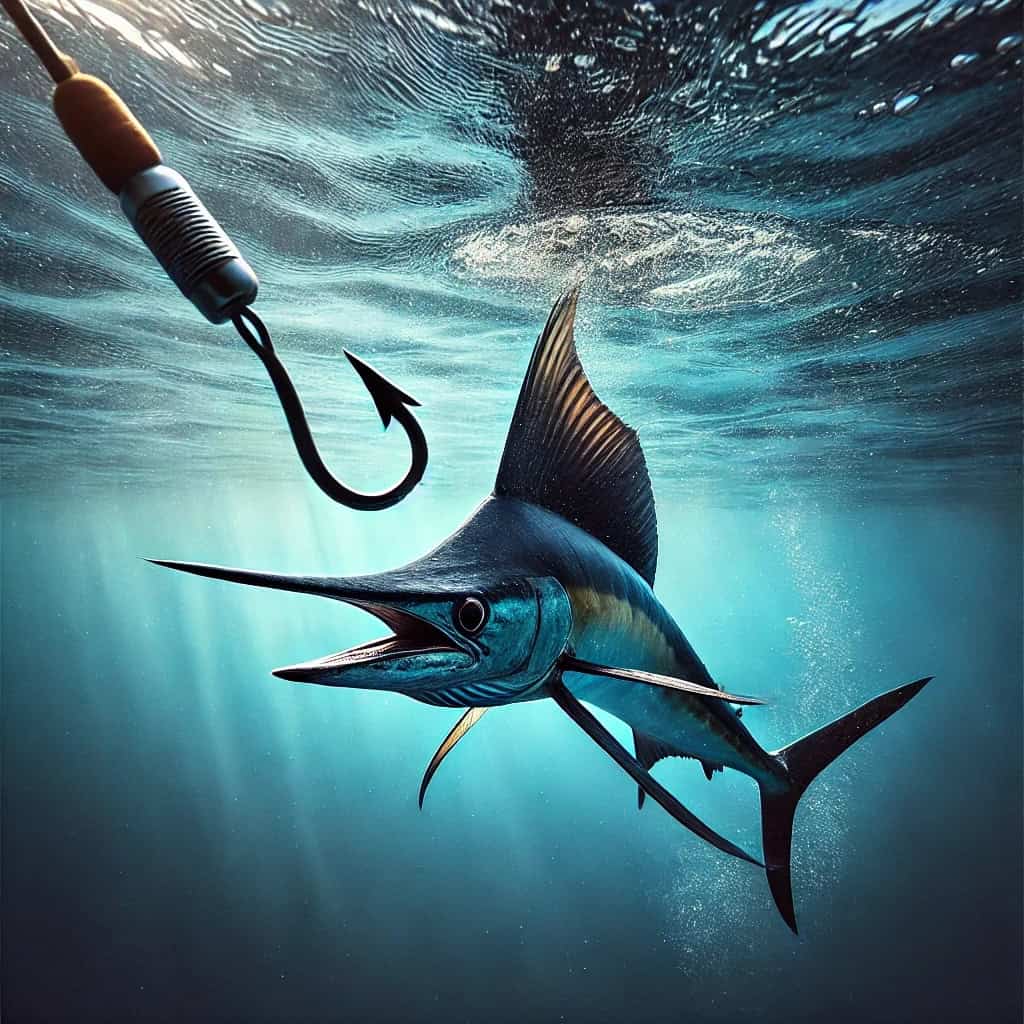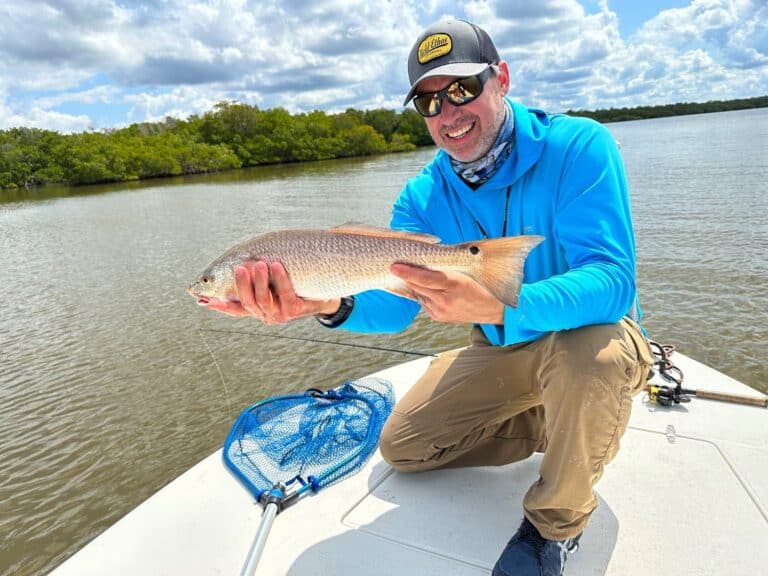Mastering the Fishing Gaff: Landing Big Catches
The Fishing gaff is an indispensable tool for anglers who regularly target large fish.
These tools are designed to assist in landing big catches by providing a secure way to handle and lift fish into the boat or onto the dock.
In this comprehensive guide, we’ll explore the different types of fishing gaffs, their uses, and techniques for effectively using them.
Mastering the intricacies of fishing gaffs can elevate your angling skill and boost your catch rate significantly.
What is a Fishing Gaff?
A fishing gaff is a long pole with a sharp hook or prong at one end, used to catch or lift fish out of the water.

The gaff’s primary purpose is to secure large fish that are difficult to handle with a fishing net, especially when the fish are heavy, strong, or have sharp fins or teeth.
Gaffs come in various sizes and styles, each suited to specific types of fishing and fish species.
Components of a Fishing Gaff:
- Handle: The handle is the long pole of the gaff, which can be made of materials like aluminum, fiberglass, or wood. It provides leverage and reach, allowing anglers to extend their reach into the water.
- Hook: The hook or prong is the business end of the gaff. It is typically made of stainless steel or other durable metals to withstand the stress of pulling large fish. The hook’s size and shape can vary depending on the intended use.
- Grip: Many gaffs come with a grip on the handle to provide better control and reduce the risk of slipping, especially when hands are wet or slippery from fish slime.
Types of Fishing Gaffs
Fishing gaffs come in different types, each designed for specific fishing scenarios.
Choosing the right type of gaff depends on the size and species of fish you’re targeting and the fishing environment.
1. Standard Gaffs: Standard gaffs are the most common type and are versatile for various fishing situations. They have a straight handle with a single hook at the end. The length of the handle can range from a few feet to over ten feet, depending on the angler’s preference and the type of fish being targeted. These gaffs are ideal for landing fish from a boat or dock.
2. Flying Gaffs: Flying gaffs are designed for very large and powerful fish, such as marlin, tuna, and sharks. Unlike standard gaffs, flying gaffs have a detachable hook connected to a rope. Once the hook secures the fish, the angler can release the handle, allowing the rope to play out as the fish fights. This design minimizes the risk of the fish escaping and reduces the strain on the angler.
3. Fixed Gaffs: Fixed gaffs are shorter and more compact, making them suitable for kayak fishing or small boats where space is limited. These gaffs have a shorter handle and are often used for smaller species or in situations where a full-length gaff would be impractical.
4. Tailer Gaffs: Tailer gaffs are specialized tools used to secure fish by the tail. They have a U-shaped hook that is slid over the fish’s tail and then pulled tight. This type of gaff is commonly used in situations where traditional gaffing could damage the fish, such as when catch-and-release fishing.
5. Custom Gaffs: Some anglers prefer custom gaffs tailored to their specific needs and preferences. Custom gaffs can vary in handle length, hook size, and material, providing a personalized tool for the angler’s fishing style and target species.

Uses of Fishing Gaffs
Fishing gaffs serve multiple purposes in fishing, primarily focused on safely landing and handling fish.
Here are some of the key uses:
1. Landing Large Fish: The primary use of a fishing gaff is to land large fish that are difficult to bring aboard with a net. Gaffing allows the angler to control the fish’s movements and lift it out of the water without relying solely on the fishing line, which can be prone to breaking under the weight and struggle of a big catch.
2. Preventing Line Breakage: When a large fish is close to the boat, it may make sudden, powerful movements that can stress the fishing line. Using a gaff allows the angler to secure the fish quickly, reducing the risk of the line snapping and losing the catch.
3. Handling Dangerous Fish: Some fish species have sharp fins, teeth, or spines that can injure the angler if handled improperly. A gaff provides a safe way to control these fish, minimizing the risk of injury.
4. Assisting in Catch-and-Release: While gaffs are often associated with keeping fish, certain types, such as tailer gaffs, can be used in catch-and-release scenarios. These gaffs allow anglers to secure and release the fish without causing significant harm, especially when targeting species with conservation concerns.
Techniques for Using a Fishing Gaff
Using a fishing gaff requires skill and precision to ensure the fish is landed safely and efficiently.
Here are some techniques to consider:
1. Preparing the Gaff: Before attempting to gaff a fish, ensure that the gaff is ready and within easy reach. The handle should be free of obstructions, and the hook should be sharp and clean. If using a flying gaff, ensure the rope is coiled neatly and ready for deployment.
2. Positioning the Fish: Guide the fish alongside the boat or dock, ideally with the head pointed towards the gaff. This positioning allows for a clean gaff shot and helps prevent the fish from escaping. Use the boat’s movement or gently guide the fish with the fishing line to achieve the desired position.
3. Gaffing the Fish: The most common gaffing point is behind the fish’s head or in the shoulder area, where the flesh is thick and provides a secure hold. Avoid gaffing in areas with vital organs or near the tail, as this can cause unnecessary damage to the fish. For a successful gaff, move smoothly and decisively. Aim for a clean hook set without excessive force. Once the hook is in place, lift the fish quickly and steadily, using the gaff handle to support the fish’s weight.
4. Handling the Fish: Once the fish is gaffed and brought aboard, handle it carefully. If releasing the fish, use a dehooking tool to remove the hook and return the fish to the water promptly. Avoid handling the fish by the gills or eyes, as these are sensitive areas.
5. Safety Considerations: Always prioritize safety when using a gaff. Wear gloves to protect your hands from sharp fins. Be mindful of the sharp hook and avoid swinging the gaff near other people. When not in use, store the gaff securely to prevent accidents.
Choosing the Right Fishing Gaff
Selecting the right fishing gaff depends on several factors, including the type of fish you’re targeting, the fishing environment, and your personal preferences.
Here are some considerations:
1. Target Species: The size and strength of the fish you target will influence the type of gaff you need. For large species like marlin or tuna, a flying gaff with a robust hook and long handle is ideal. For smaller species, a standard or fixed gaff may suffice.
2. Fishing Environment: Consider the fishing environment when choosing a gaff. Longer handles are beneficial for offshore fishing from larger boats, while shorter handles are more practical for inshore or kayak fishing.
3. Material: The material of the gaff handle and hook can affect its durability and performance. Aluminum and fiberglass handles are lightweight and corrosion-resistant, making them suitable for saltwater fishing. Stainless steel hooks are durable and provide a strong grip on the fish.
4. Customization: Custom gaffs offer the flexibility to choose specific features that match your fishing style. Customization options include handle length, hook size, grip type, and additional features like wrist straps or lanyards.
5. Brand and Quality: Invest in a high-quality gaff from a reputable brand. A well-made gaff will be durable, reliable, and capable of handling the stress of landing large fish.
Maintenance and Care of Fishing Gaffs
Proper maintenance and care of your fishing gaff are essential for its longevity and performance.
Here are some tips:
1. Cleaning: After each use, rinse the gaff with fresh water to remove salt, blood, and other residues. Pay special attention to the hook, as dried fish blood and scales can cause corrosion. Dry the gaff thoroughly before storing it.
2. Sharpening: Keep the hook sharp to ensure clean and efficient gaffing. Use a file or sharpening tool to maintain the hook’s edge, being careful not to over-sharpen, which can weaken the metal.
3. Storage: Store the gaff in a secure location. Consider using a protective cover for the hook to prevent accidents and damage. If your gaff has a detachable hook, store it separately to avoid bending or dulling.
4. Regular Inspection: Regularly inspect your gaff for signs of wear and damage. Check the handle for cracks, the grip for wear, and the hook for any signs of rust or bending. Replace any damaged parts to ensure the gaff’s effectiveness and safety.
Conclusion: Mastering the Art of Gaffing
Fishing gaffs are essential tools for anglers targeting large fish.
Understanding the different types of gaffs, their uses, and proper techniques can enhance your fishing experience and improve your success rate.
By selecting a gaff that suits your fishing style and maintaining it with care, you’ll be well-equipped to handle any fishing challenge.
Remember, using a gaff is not just about securing your catch; it’s also about respecting the fish and the sport.
Master the art of gaffing, and you’ll find it an invaluable skill in your angling repertoire.
Happy fishing, and may your gaffing adventures be both successful and ethical!



